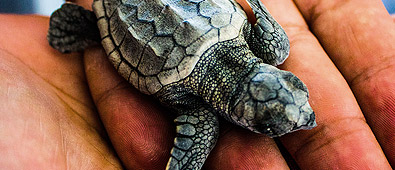Resilience & Restoration
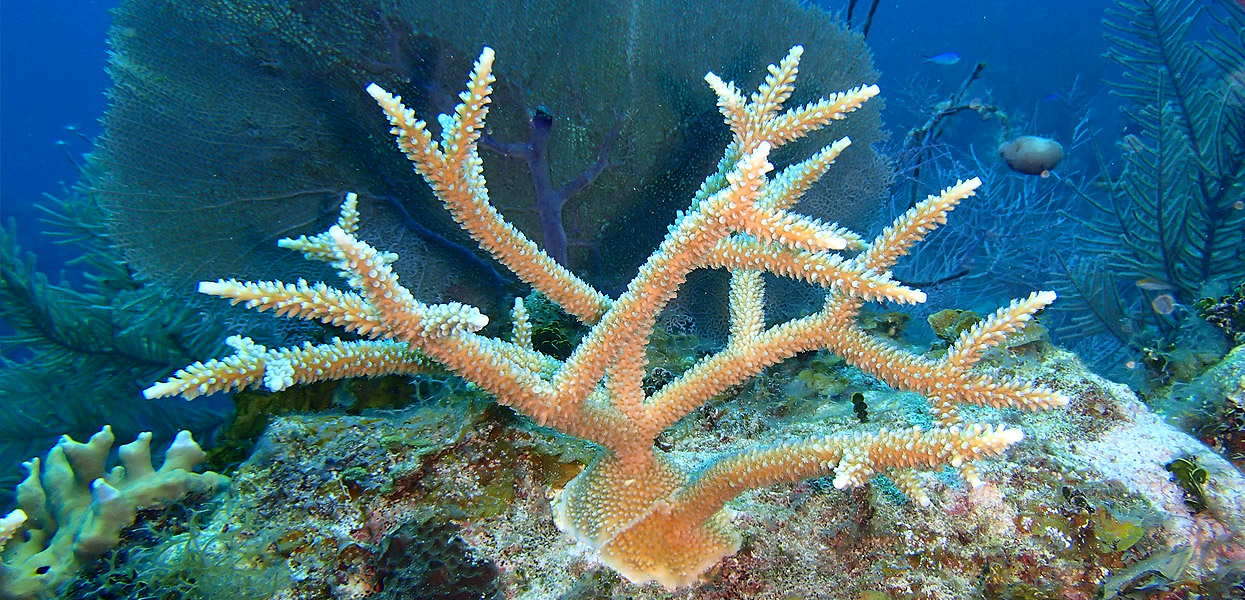
The newly formed Reef Ecology and Evolution Laboratory (REEL) at the Central Caribbean Marine Institute is focused on understanding how ecosystems function in order maintain biodiversity. Using a combination of large-scale in situ ecological surveys, small-scale laboratory experiments, and molecular ecology, we examine population structure, reproductive ecology, and genetic connectivity on tropical coral reef ecosystems, ranging from shallow inshore reefs to the mesophotic zone. Upcoming projects range from understanding molecular and physiological mechanisms of adaptation by corals to extreme environments, to enhancing reef complexity using out-planting techniques to restore key ecosystem functions. Both theoretical and applied, the research conducted by the REEL group will advance our understanding of how coral reefs and all of the organisms that reside there will not only survive, but thrive, under future environmental conditions.
Current Projects
- Assessing the mechanisms of molecular and morphological adaptation by corals to extreme environments, funded by the National Science Foundation.
This collaborative study between CCMI and the University of Haifa, Israel, addresses two primary research questions: (1) how does coral morphology and physiology differ across depth and (2) are these differences due to plasticity or evolutionary adaptation? Using a multifaceted approach, including advanced molecular and imaging techniques, we will examine the mechanisms that enable corals to thrive across broad depth gradients in the Caribbean and the Red Sea.
- Enhancing Ecosystem Complexity to Promote Sustainable Fish Communities, funded by the Alexandria Foundation
As habitat complexity degrades, it is important to find means of intervention that can re-create the three-dimensional structure of coral reefs in order to sustain fish populations. This project seeks to understand the impacts of coral restoration out-planting, used as a mechanism to increase reef complexity, on the abundance and diversity of fish populations all the way up the food chain. Ultimately, results of this work could help determine if we can re-create complex reef systems that promote sustainable populations of commercially important fish species. Importantly, if successful this could be used as a mechanism to restore sites where commercially important fish stocks have declined.
- Variations in Nursery Coral Out-Planting Success on Raised 3-Dimensional Domes Across a Depth Gradient. Funded by the AALL Foundation
The success of coral out-planting from nurseries in the Caribbean has varied widely. Previous work at CCMI has shown that fragments of staghorn corals from our nurseries have a higher survival rate when elevated off the benthos onto three-dimensional structures. This study seeks to further our understanding of out-plant success by examining how the depth of the out-planting site impact growth and survival on these three-dimensional structures. The information gained from this project will be use to scale-up our out-planting and restoration strategies and can inform regional and international restoration efforts.
Example Pending Projects
- Increasing Coral Reef Resilience with Assisted Evolution via Selective Restoration, potential funding source ReSEMBiD
Restoration activities at CCMI have documented differences in the response of individuals to disease outbreaks and heat stress events, either through genetics or plasticity. Through our understanding of disease resistance and heat tolerance we will assist the evolution of the acroporid populations by selecting for the most tolerant individuals that will then be used to restore nearshore coral reef sites, creating reefs with higher tolerance to the main threats affecting corals. This project, therefore, will promote local reef resilience and sustain biodiversity and ensure the persistence of reefs into the foreseeable future in the Cayman Islands.
- Using patterns of fine-scale genetic connectivity to understand habitat use and inform management of invasive lionfish populations in the Cayman Islands, potential funding source DarwinPlus Initiative
We know lionfish are present along a broad depth gradient but how connected are these populations? Using a combination of in-situ surveys and molecular population genetic analysis we will determine the role of deep reefs as a refuge for lionfish populations and the degree of connectivity among depths. Understanding if these populations are connected will determine if culling in shallow habitat alone is effective at controlling populations or if culling of deeper sites needs to be incorporated.
- Scaling Observational Coral Reef Ecology from Cells to Sea-Scape, potential funding source NSF
To accurately understand how an ecosystem functions and is maintained, multiple facets of scale need to be considered in combination. Recent advances in molecular techniques (eDNA), diving technologies (e.g., closed-circuit rebreathers, application of mixed gases, etc.), field robotics (e.g., Autonomous Underwater Vehicles -AUVs, Remotely Operated Vehicles, -ROVs), and survey techniques (e.g., sonar and benthic optical imagery) from surface vessels allow the full geographic extent of coral reef systems to be explored in an unprecedented way. This study, in collaboration with researchers from the University of Delaware, we will combine all of these tools and techniques in order to expand our characterizations of corals reefs across of broad range of scales. Exploring coral reef ecosystems at multiple interwoven levels using coordinated technologies and observations will drastically improve our understanding of the underlying processes and interactions driving local and global change and fill a critical knowledge gap.
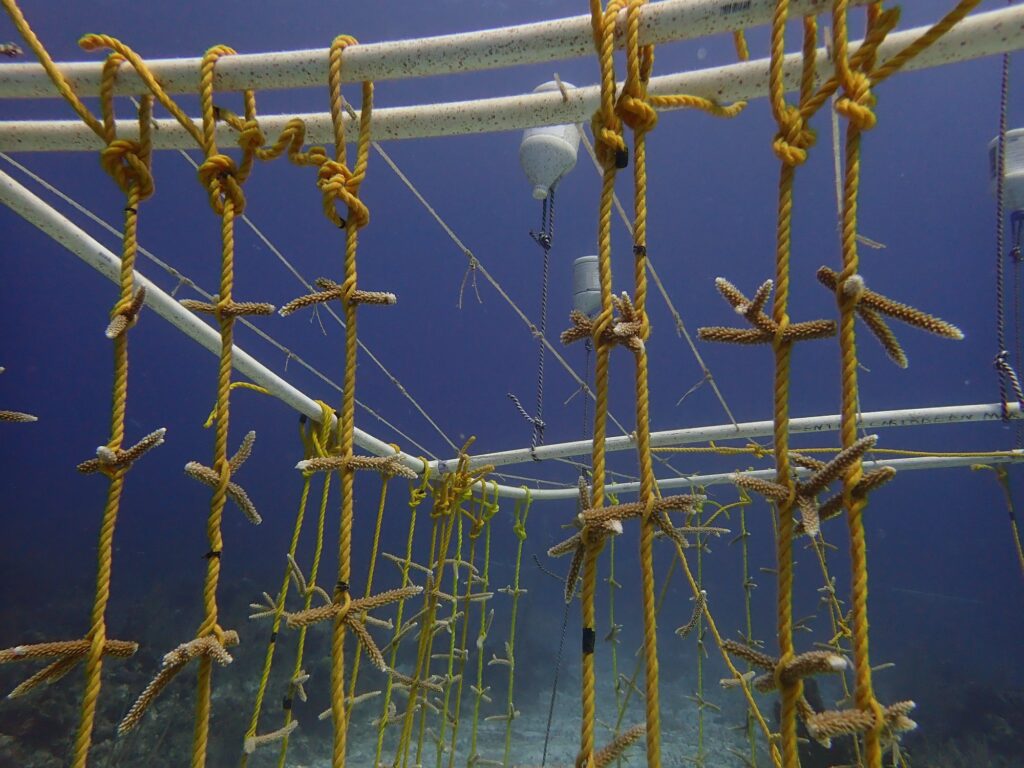
Mission of REEL
Promote resilience of coral reefs ecosystems through increased understanding of adaptation and acclimatization potential of ecosystem engineers, protection of key ecosystem functions, and identification of areas of refuge.
CORAL RESTORATION
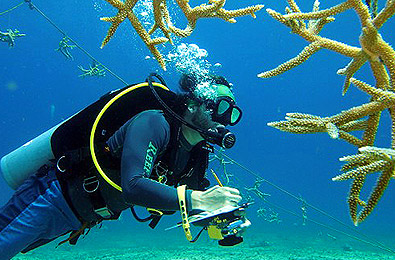
CCMI is a pioneer in the Cayman Islands in coral restoration. In 2012, a pilot study was established to explore the potential for coral nurseries. With results from this work, the Cayman Islands Department of Environment passed new policy and coral nurseries have spread across the islands, with 5 private entities currently growing coral as a result of CCMI’s work in this area.
This project seeks to have a long-term positive impact on the preservation of corals which provide the framework for all coral reefs. As with many coral restoration programmes, the staghorn coral (Acropora cervicornis) is ideal to use, due to its ease of fragmentation and growth, and it’s endangered status. The ultimate goal of coral regeneration is to help nature nurture itself. To do this, outplanted corals need to establish a viable, locally connected, sexually reproductive population. The more genetically diverse the nursery-reared outplants, the better. When fragments were collected from five parent colonies in 2012, it was unknown if these came from genetically distinct parents or from genetic clones. Fragments were tagged and kept separate from one another within the nursery until genetic analyses could be performed. Recent results from genetic work on an additional 100 corals from across the three Cayman islands by University of Miami scientists (Dr. Diego Lirman and PhD candidate Crawford Drury) has led to a new understanding of the connections of the species across the region. Cayman and Florida corals show the closest relationship and new maps for improving the protection and management of threatened coral species are now in progress. This information will not only help coral nursery managers and stakeholders to select unique donor colonies, but will also assist in guiding future outplant strategies.
Results from the collaborative genetics sampling study were used to create the first map of staghorn coral genetic distribution in the Cayman Islands. Below is the map for Little Cayman, with each yellow dot representing a genetically unique staghorn coral colony.
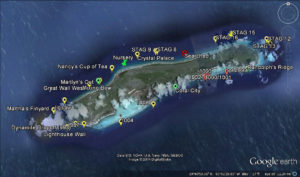
PROPAGATION IN THE NURSERY
CCMI is constantly developing and refining its coral nursery methods and techniques. Major accomplishments between 2012 and 2017 include:
- Propagation of 1000+ coral fragments starting from 10 parent colonies.
- The expansion of the nursery into a shallow water nursery located at 20ft of depth and a deep water nursery located at 60ft of depth. The deep nursery offers a site removed from storm activity and actually requires less maintenance than the shallow nursery.
- Nursery expansion from 1 to 15 coral “trees”, each with 100 fragments capacity. Nursery expansion and space for 15 lines to which fragments may be transferred as they outgrow the trees.
- Nursery expansion with the introduction of 12 coral “frames”, six in the shallow water nursery and six in the deep water nursery; each has the capacity to hold 50 fragments.
- Lessons learned were written into the first National Coral Nursery Policy by the Cayman Islands Department of Environment which was approved by the Cabinet in November of 2014.
- CCMI’s improved coral fragmentation method was published in the Endangered Species Research scientific journal and presented at the Benthic Ecology Meeting (2014) in Jacksonsville, FL.
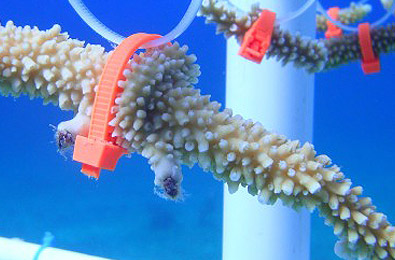
RETURN-TO-THE-WILD (OUTPLANTING)
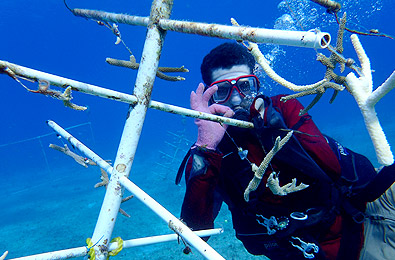
CCMI has already returned 1000+ nursery-reared staghorn corals to the wild at 10 sites around Little Cayman. Each outplanting site is chosen to answer a scientific question and several publications have resulted. With over 1000 corals of at least 10cm in size (TLE), nursery-reared colonies contributed over 10,000+ cm (100 m) of additional staghorn coral tissue to the wild. Outplanting sites are monitored for at least five years and the success of these sites has been mixed. More work will be conducted in the coming years to understand what makes a successful outplanting site.
Studying outplanting success is an ongoing research effort which includes:
- Deep Water Strategies: Results will help us determine how deep our shallow nursery-reared corals can be outplanted.
- Shallow Water Strategies: Results will help determine whether it is possible to regenerate the shallow waters of lagoon reefs and backreef areas where staghorn and elkhorn corals once thrived.
- Biodiversity Recruitment: Results will identify structural preferences of early settlers (fish, shrimp, other reef creatures) to help improve the design of outplant plots.
ELKHORN CORAL – THE NEXT NURSERY SPECIES
CCMI is the primary research site for stony coral restoration throughout the Cayman Islands. As we are fine-tuning our work using staghorn coral, we have begun work with elkhorn coral (Acropora palmata), another Evolutionarily Distinct and Globally Endangered (EDGE) species. The goal is to sample 150 elkhorn coral colonies to determine whether they are genetically distinct.
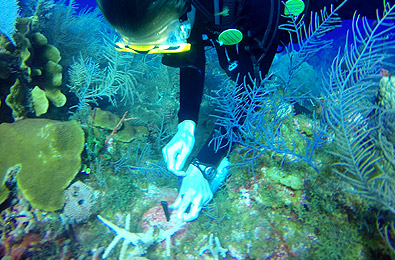
SPONSORS OF THE LITTLE CAYMAN CORAL NURSERY
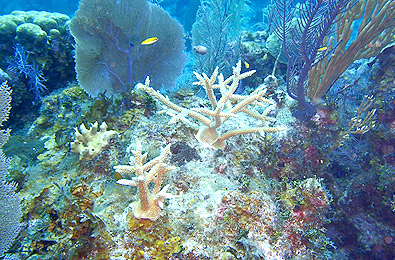
The Little Cayman Nursery is permitted by the Department of Environment, under the auspices of the National Coral Nursery Policy.
This project is sponsored by
Dart Cayman Islands, the Disney Conservation Fund, the Dart Foundation, Ernest Kleinwort Charitable Trust, Consolidated Water Company, Stuarts Walker Hersant Humphries, the AALL Foundation, an anonymous donor, and the Darwin Plus Initiative.



